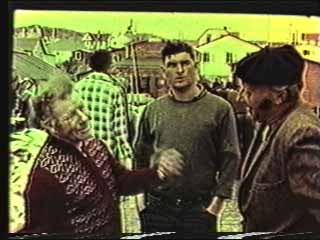1967. Here Fred Earle (right), field worker for Memorial
University's extension service, is being filmed by a
National Film Board of Canada's crew as he chats with
two fishermen. The film board, as part of its Challenge
for Change program, teamed up with the university
to create 28 films, largely unedited, which sought to express
the voice of a people facing the destruction of their
communities and their way of life. It was the time of
government's official resettlement program, designed to
force people from their villages to relocate in growth centres.
More than 300 small communities were disappeared.
But Fogo Island did not disappear. Today, when government
facilitates resettlement but dares not speak its name, the Fogo Island
Co-operative is prospering. One must be very careful about
exaggerating the significance of the Fogo Process of the 1960s; it is only one
factor in a success story for which most credit must be given to the people.
As film producer Colin Low said,
the films "intensified" a process already begun.
Please note if you linked here from the Best Practices project, these images are related to the broad theme of participatory communications. There are also image links specific to each case study. |

"Too foolish to talk about" was Billy Crane's description of
government's treatment of inshore fishermen. But Billy
moved away, as did thousands of other Newfoundlanders,
to jobs in southern Ontario.
It's important to stress the role of the field worker, in this case Fred Earle -
himself a native of Fogo - who not only worked with the film crew in the
community, but also discussed the films, after showings, with the people.
The films, in effect, mirrored the environment and concerns of the
people. In the early days of extension, field workers were
expected to spend the first year of their tenure just getting to know
and being accepted by the community. Also, for a field worker,
a university education was considered to be a liability.

Lord Taylor, president of
Memorial University (left) and
Don Snowden, director of the extension department,
announce the formation of a Newfoundland film unit in 1968.
The purpose of the film unit was communications in support
of rural development.

Many Newfoundlanders still remember the sight of homes being
towed over water during the implementation of the
official federal/provincial government resettlement program.
In 1968 the film unit travelled from St. John's to the northern
peninsula to work with field worker George Billard on the
Port au Choix Project.

Olga Spence, post-mistress of Port au Choix, is one of the most
powerful voices of the early films. As an early attempt to humanize
communications technology, principles were established, such
as the need for a sensitive film crew and the approval screening -
where participants in the film were given the opportunity to
judge if the films actually represented what they wanted to
say.

The film unit also journeyed to Labrador, where Tony
Williamson was the extension field worker. They made 12
films in one summer. Tony later became the director of the
Don Snowden Centre for Development Support
Communications at Memorial University. The centre was
closed by MUN in 1995 and resurrected
by the University of Guelph.
